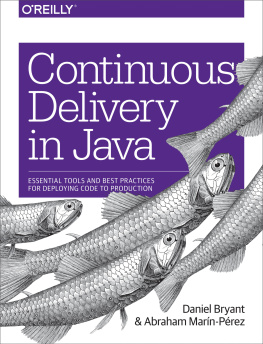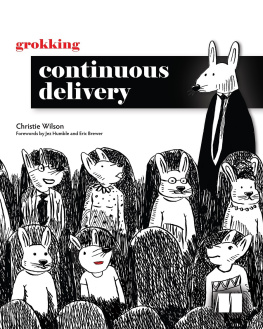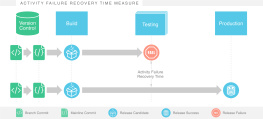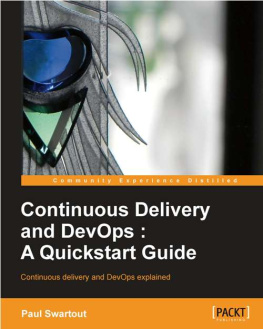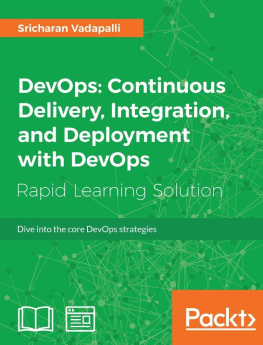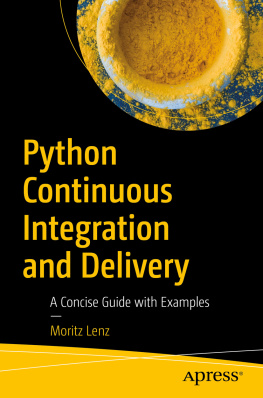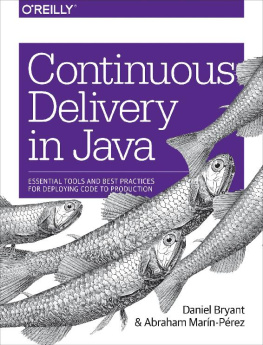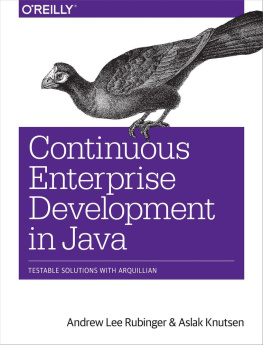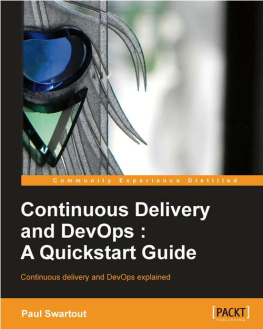Abraham Marín-Pérez - Continuous Delivery in Java
Here you can read online Abraham Marín-Pérez - Continuous Delivery in Java full text of the book (entire story) in english for free. Download pdf and epub, get meaning, cover and reviews about this ebook. year: 2018, publisher: OReilly Media, Inc., genre: Romance novel. Description of the work, (preface) as well as reviews are available. Best literature library LitArk.com created for fans of good reading and offers a wide selection of genres:
Romance novel
Science fiction
Adventure
Detective
Science
History
Home and family
Prose
Art
Politics
Computer
Non-fiction
Religion
Business
Children
Humor
Choose a favorite category and find really read worthwhile books. Enjoy immersion in the world of imagination, feel the emotions of the characters or learn something new for yourself, make an fascinating discovery.
- Book:Continuous Delivery in Java
- Author:
- Publisher:OReilly Media, Inc.
- Genre:
- Year:2018
- Rating:4 / 5
- Favourites:Add to favourites
- Your mark:
- 80
- 1
- 2
- 3
- 4
- 5
Continuous Delivery in Java: summary, description and annotation
We offer to read an annotation, description, summary or preface (depends on what the author of the book "Continuous Delivery in Java" wrote himself). If you haven't found the necessary information about the book — write in the comments, we will try to find it.
Continuous Delivery in Java — read online for free the complete book (whole text) full work
Below is the text of the book, divided by pages. System saving the place of the last page read, allows you to conveniently read the book "Continuous Delivery in Java" online for free, without having to search again every time where you left off. Put a bookmark, and you can go to the page where you finished reading at any time.
Font size:
Interval:
Bookmark:

by Daniel Bryant and Abraham Marn-Prez
Copyright 2019 Daniel Bryant and Cosota Team Ltd. All rights reserved.
Printed in the United States of America.
Published by OReilly Media, Inc. , 1005 Gravenstein Highway North, Sebastopol, CA 95472.
OReilly books may be purchased for educational, business, or sales promotional use. Online editions are also available for most titles (http://oreilly.com/safari). For more information, contact our corporate/institutional sales department: 800-998-9938 or corporate@oreilly.com .
- Editor: Virginia Wilson
- Production Editor: Nicholas Adams
- Copyeditor: Sharon Wilkey
- Proofreader: Marta Justak
- Indexer: Ellen Troutman-Zaig
- Interior Designer: David Futato
- Cover Designer: Karen Montgomery
- Illustrator: Rebecca Demarest
- November 2018: First Edition
- 2018-11-06: First Release
See http://oreilly.com/catalog/errata.csp?isbn=9781491986028 for release details.
The OReilly logo is a registered trademark of OReilly Media, Inc. Continuous Delivery in Java, the cover image, and related trade dress are trademarks of OReilly Media, Inc.
The views expressed in this work are those of the authors, and do not represent the publishers views. While the publisher and the authors have used good faith efforts to ensure that the information and instructions contained in this work are accurate, the publisher and the authors disclaim all responsibility for errors or omissions, including without limitation responsibility for damages resulting from the use of or reliance on this work. Use of the information and instructions contained in this work is at your own risk. If any code samples or other technology this work contains or describes is subject to open source licenses or the intellectual property rights of others, it is your responsibility to ensure that your use thereof complies with such licenses and/or rights.
978-1-491-98602-8
[LSI]
Theres been broad agreement in the Continuous Delivery community that tools dont matter ever since Dave Farley and Jez Humble wrote Continuous Delivery. There are plenty of good programming languages out there, and plenty of good tools for building, testing, and deploying your code to production. The wisdom of the crowd has been: it doesnt matter which tools you use, as long as you avoid the really terrible tools.
This year, that wisdom has been augmented by the work of Dr. Nicole Forsgren, Jez Humble, and Gene Kim. Their book Accelerate summarises multiple years of research into Continuous Delivery and IT performance. One of their conclusions is the ability for teams to choose their own tools has a strong, statistical impact on Continuous Delivery. So, now the wisdom of the crowd is: it doesnt matter which tools you use, as long as youre able to choose them yourself and you avoid the really terrible tools.
Take me, for example. The first time I did Continuous Delivery on a team was at Elsevier in 2007. We built a journal website in Java 6, Spring 2, and Tomcat 6 using XP practices like TDD and CI. The pipeline was Ant and Cruise Control. The codebase was always releasable, and once a week we deployed to production.
The first time I did Continuous Delivery across an entire company was at LMAX in 2008. We built a state of the art financial exchange in Java 6, Spring 3, and Resin 3 using XP practices and Domain Driven Design. The pipeline was Ant and Cruise Control, with a lot of custom dashboards. The codebase was always releasable, and once a fortnight we deployed to production.
Im sure you can see the similarities there. Groups of smart people worked closely together. XP practices and sound design principles were essential. The tools used were deliberately chosen for the task at hand. And in the case of LMAX, it helped that the Head of Development was writing the inaugural book on Continuous Delivery at the time. I think his name was Dafydd, or Dev, or something.
What this all means is you can use Java, or PHP, or .NET, and successfully implement Continuous Delivery. You can use Solaris Zones, or Docker. You can use AWS, Azure, or that on-premises data centre your Head Of Platform keeps saying is cheaper than AWS. Just make sure you choose your tools yourself, for the particular problems you face. And dont use MKS for version control, QTP for testing, or any commercial release management tool. Theyre terrible.
So, if tools dont matter for Continuous Delivery as long as you choose them yourself and theyre not terrible choices, why am I writing this foreword?
Theres actually a nuanced answer in here, if we look hard enough. Tools dont matter as much as the principles and practices of Continuous Delivery, but they still matter a great deal. Programming languages can help people to quickly create new features and defect fixes, which reduces the Cost of Delay associated with product development. Programming languages can also encourage a testable, releasable application architecture, which are key enablers of Continuous Delivery. Build, test, and deploy tooling can nudge people in the right direction, towards practices such as TDD and Trunk Based Development.
I was reminded of that nuance recently, when I cleared out my childhood bedroom and found my university copy of Ivor Hortons Understanding Java 2. Java and I married each other in 1999, and now its been so long weve both forgotten its our 20 year anniversary very soon. In my opinion, its a great programming language. Over the years Java, JUnit, Gradle, Spring and many other tools have helped me to build well-tested, releasable applications, and encourage people to adopt Continuous Delivery.
With Cloud, containerization, and Serverless leading our inexorable march towards Skynet, we all need guidance from experienced practitioners on how to use the latest tools and work towards Continuous Delivery. In this book, Daniel and Abraham explain how to use Java and popular tools such as Spring Boot, Kubernetes, and AWS EKS to deliver modern web applications frequently enough to meet market demand. IT practitioners working with Java and any of the other tools mentioned in this book can rely on Daniel and Abraham to explain how to implement a Continuous Delivery toolchain for their applications.
Steve Smith
Continuous Delivery consultant at Continuous Delivery Consulting
Continuous delivery is one of the key practices that should be at the heart of any engineering team. We have often been asked what are some of the key enablers of success at jClarity and new build farm for OpenJDK/Java at adoptopenjdk.net. The answer is that we can deploy daily with the greatest of confidence, and do this with minimal engineering teams. Ever since Dave Farleys and Jez Humbles seminal Continuous Delivery: Reliable Software Releases through Build, Test, and Deployment Automation (Addison-Wesley Signature) came out in 2010, folks have started adopting continuous delivery practices, but there has not been a comprehensive guide on how to do this for the ~10 million Java developers out there. Well, now there is!
Daniel and Abraham are both real-world practitioners and their book contains everything you need as a Java developer on this topic, with in-depth explanations as to why you want to follow the practices of continuous delivery; how to architect your application in a way that is amenable to this; how to put together build, test, and deploy pipelines; and also the intricacies of deploying to cloud and container environments.
Font size:
Interval:
Bookmark:
Similar books «Continuous Delivery in Java»
Look at similar books to Continuous Delivery in Java. We have selected literature similar in name and meaning in the hope of providing readers with more options to find new, interesting, not yet read works.
Discussion, reviews of the book Continuous Delivery in Java and just readers' own opinions. Leave your comments, write what you think about the work, its meaning or the main characters. Specify what exactly you liked and what you didn't like, and why you think so.

